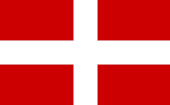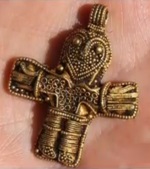Dannebrog Cross

Denmark
The Dannebrog Cross dates from the 13th century and is the oldest state flag in the world. It's similar to the Swiss Cross, but where the white cross on the Swiss flag is couped, the white arms of the Danish cross extend to the edges of the field.
There are also similarities with the flag of Savoy, Italy. The official red colour differs slightly, but the main difference is the position of the vertical bar which is central on the Savoy flag (the left and right red rectangles are the same size). On the Danish flag, the vertical bar is closer to the flagpole (the red parts on the hoist side are square).
The reason for the off-centered positioning is explained below.
Danne and brog are old Danish words that mean Denmark and cloth. Therefore Dannebrog is the name of the Danish flag.
Why is the cross sideways?
Is a sideways cross from the supposed collapse of St. Philip's crucifixion? No, not at all. (See St. Philip's Cross.)
Danish Christians are as aware as anyone else that the cross represent's Christ's crucifixion on an upright cross, and an upright cross remains the predominant symbol of Christianity in Denmark.
This awareness can be traced back to the 10th century.
A 10th century crucifix found by a man with a metal detector could end up rewriting the history of Christianity in Denmark.
The gold pendant was recently discovered near a church on the island of Funen. Experts have since examined the piece and believe it dates back to between 900 and 950 AD. If they are correct, that will make it the oldest representation of Christ on a cross known to the area. At present, that distinction goes to the Jelling Stones, two large carved pieces in Jutland that were raised in 965 AD.
While Christian missionaries began attempting to convert the Vikings in the 700s, the faith didn't become popular until the 11th century.
This discovery could indicate the Danish adoption of the religion began earlier than believed.
Source: aol.com/...
The Dannebrog Cross is just a horizontal form of the upright Latin Cross, that is often referred to in jewellery as a Sideways Cross. There's no particular meaning to this orientation; like all crosses, the interpretation is whatever we want it to be. In the case of this cross, its orientation is for pragmatic reasons.
When carried in battle, a short flagpole is lighter and stronger than a long one, yet the flag can be larger if it is sideways.
For a given length of flagpole, a horizontal rectangular flag is larger than a vertical rectangular or square flag. This has resulted in most national flags having a horizontal rectangle shape and a horizontal cross is simply to suit that shape.
National and regional flags that incorporate the Nordic Cross
The Dannebrog Cross is also known as the Nordic Cross and is the basis for all flags in Scandinavia. These include the flags of
Denmark (of course)
Finland
Åland Islands, Finland
Norway
Faroe Islands, Denmark
Sweden
Skåneland
plus neighbouring places that are not always considered Scandinavian, such as
Shetland Islands, Scotland
Orkney, Scotland
Iceland
The Nordic Cross is also central to the flags of:
Aldtsjerk, Netherlands
Alegre, Brazil
Alüksne, Latvia
Andalucía, Colombia
Areias, Brazil
Balneário Gaivota, Brazil
Barra, Scotland
Bayamón, Puerto Rico
Borborema, Brazil
Calais, France
Carmo do Paranaíba, Brazil
Catholic Cathedral of Stockholm, Sweden
Cësis, Latvia
Chapadinha, Brazil
Colorado, Brazil
Domingos Martins, Brazil
East Karelia, Russia
Escada, Brazil
Frei Martinho, Brazil
Grão Pará, Brazil
Guaíra, Brazil
Highlands, Scotland
Itu, Brazil
Jacupiranga, Brazil
Lagoa Formosa, Brazil
Little Rock, USA
Mi'kmaq people,
Canada and US border
Nova Era, Brazil
Palotina, Brazil
Pärnu, Estonia
Peritiba, Brazil
Pirapora do Bom Jesus, Brazil
Santo Antônio do Pinhal, Brazil
Santo Cristo, Brazil
São Paulo, Brazil
South Uist, Scotland
Stavropol Krai, Russia
Tbilisi, Georgia
Ventspils, Latvia
Vepsia, Russia
Vinhedo, Brazil
Volyn (Volyns'ka) Oblast, Ukraine
Wilmington, USA
Zaječar, Serbia
Denmark is where Lego comes from (and Danes of course). It is also the happiest place on earth, according to Science Daily. As mentioned above, the Danish and Swiss flags are similar, and the same survey calculated that second happiest place is Switzerland. All Nordic countries are high in the happiness league.
It must be the flag!
Other Crosses on flags
One interpretation is related to the words of Jesus: "Take up your cross and follow me" (Mark 8:34). The cross was the instrument of torture and death; for Jesus this meant not only his physical death but also the spiritual death for our sins. After that, as you know, he rose to heaven. So "Take up your cross and follow me" is the invitation from Jesus to kill our sins and follow Jesus on the path to heaven. (See the Meaning of the Cross) If somebody takes up their cross and follows Jesus to the end of their days, when they die their relatives might honour that person by showing their cross has been carried to the end and it is symbolically laid down.
Crosses are usually erect on gravestones, but for the reason above, they are sometimes horizontal, resting on the grave.
University of Leicester (2006, November 14). Psychologist Produces The First-ever 'World Map Of Happiness'. ScienceDaily. Retrieved January 8, 2008, from sciencedaily.com/...

Portland flag

Portland rivers
The flag of Portland, Oregon, is not supposed to feature a disjointed Nordic Cross; the blue lines are meant to represent the rivers that converge in the city.
Can you see the similarity between the flag and the rivers? No, neither can we. But as mentioned above, a cross, and a flag, mean whatever we want it to mean.



